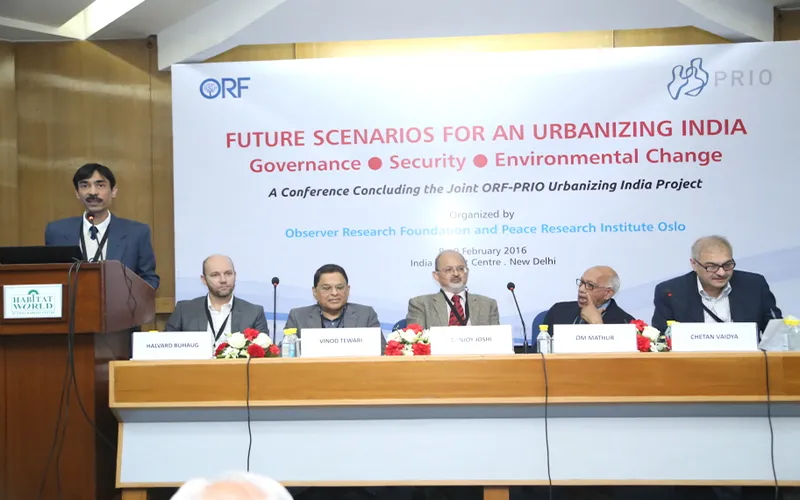-
CENTRES
Progammes & Centres
Location

Experts say intelligent actions by the current leadership would be needed to achieve the vision of a sustainable and inclusive urban India as envisaged under the newly launched Smart Cities Mission.
This issue was flagged by experts participating in a two-day international conference on ‘Future Scenarios for an Urbanising India’, organised in New Delhi by Observer Research Foundation (ORF) and the Peace Research Institute Oslo (PRIO) from February 8, 2016.
The event was an important concluding exercise of a three-year collaborative research project undertaken by ORF and PRIO, exploring a fundamental question: Given the challenges of urban expansion and sprawl, social and economic exclusion, and deteriorating environmental conditions at the regional level, how do we manage and govern an urbanising India?
Over 30 leading scholars and experts representing prominent institutions like CURE, IIHS, IIPA, NFI, NIUA, NIC, OPML, SPA, TERI, TCPO, University of Maryland, Uppsala University, etc. and private agencies participated in the conference and shared valuable experiences. This was further enriched by probing questions from a sizeable audience which was present to hear the expert opinions, contributing to the deliberations. Some important points discussed during the conference are presented below.
India is experiencing slow urbanisation, and it is only by the year 2045 or 2050 that the proportion of urban population in the country will cross the 50 per cent mark. While the scale (number) is large, the pace of change (growth rate) is slow. When compared with 22 largest countries, India has an urbanisation deficit of at least 8.7 per cent.
The real cause of urban population growth is not rural to urban migration, as is generally understood, but fertility (i.e., births/natural increase). At many places, the growth is occurring outside municipal limits (or in census towns). District level data show that urban footprints are not spreading the way they should have spread. Twenty per cent of districts in India have less than 10 per cent of the urban population.
Though it is true that cities produce high GDP, the linkages between urbanisation and economic growth are not as dominant as had been expected.
It is well recognised that urbanisation in India is not being managed properly and this situation could lead to the occurrence of numerous problems in future. Most prevalent concerns include poverty, an unmanaged informal sector, shortage of infrastructure, weak institutional arrangements, low financial base, lack of disaster preparedness, failure of urban planning and infrastructure.
The impact of previous efforts such as JNNURM has been marginal, with only some projects seeing the light of the day. The governance aspect which is the key driver for improving urban development and management was not sufficiently strengthened, despite government commitment.
The current smart cities mission is seen as a consultant–driven approach, with smart city plans being prepared by consultants. Some challenges that would be encountered during this journey include removing encroachments, slum improvement, and green field development.
It is observed that democratic allocation of public infrastructure, services and support mechanisms has not taken place, and this has led to severe inequalities of various kinds.
In view of the multiple concerns highlighted by the gathering, it is felt that wise actions on the part of the government and other stakeholders would help in overcoming the problems caused by urbanisation. Some recommendations are enumerated below.
This report is prepared by Dr. Rumi Aijaz, Senior Fellow, Observer Research Foundation, New Delhi.
The views expressed above belong to the author(s). ORF research and analyses now available on Telegram! Click here to access our curated content — blogs, longforms and interviews.